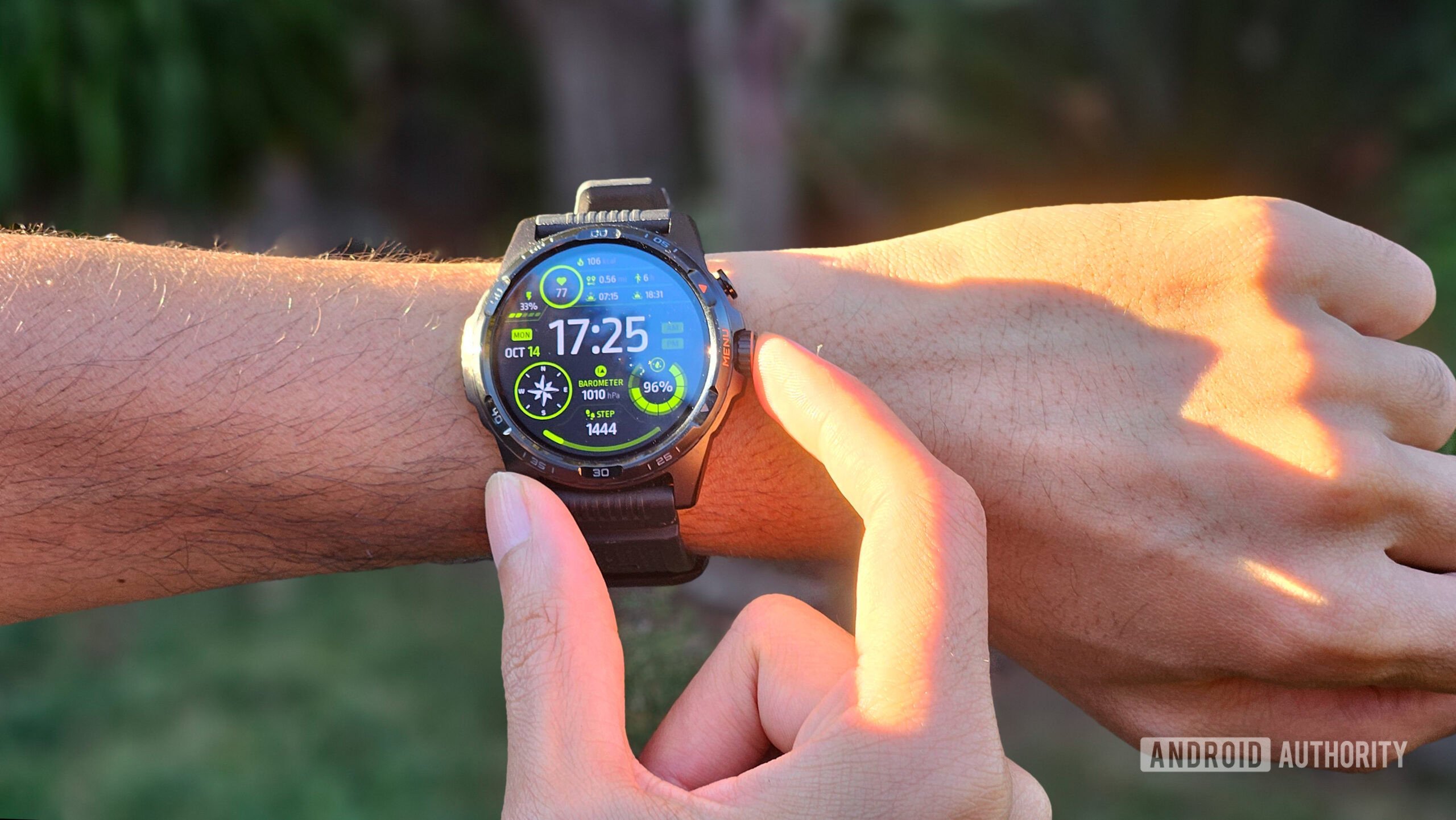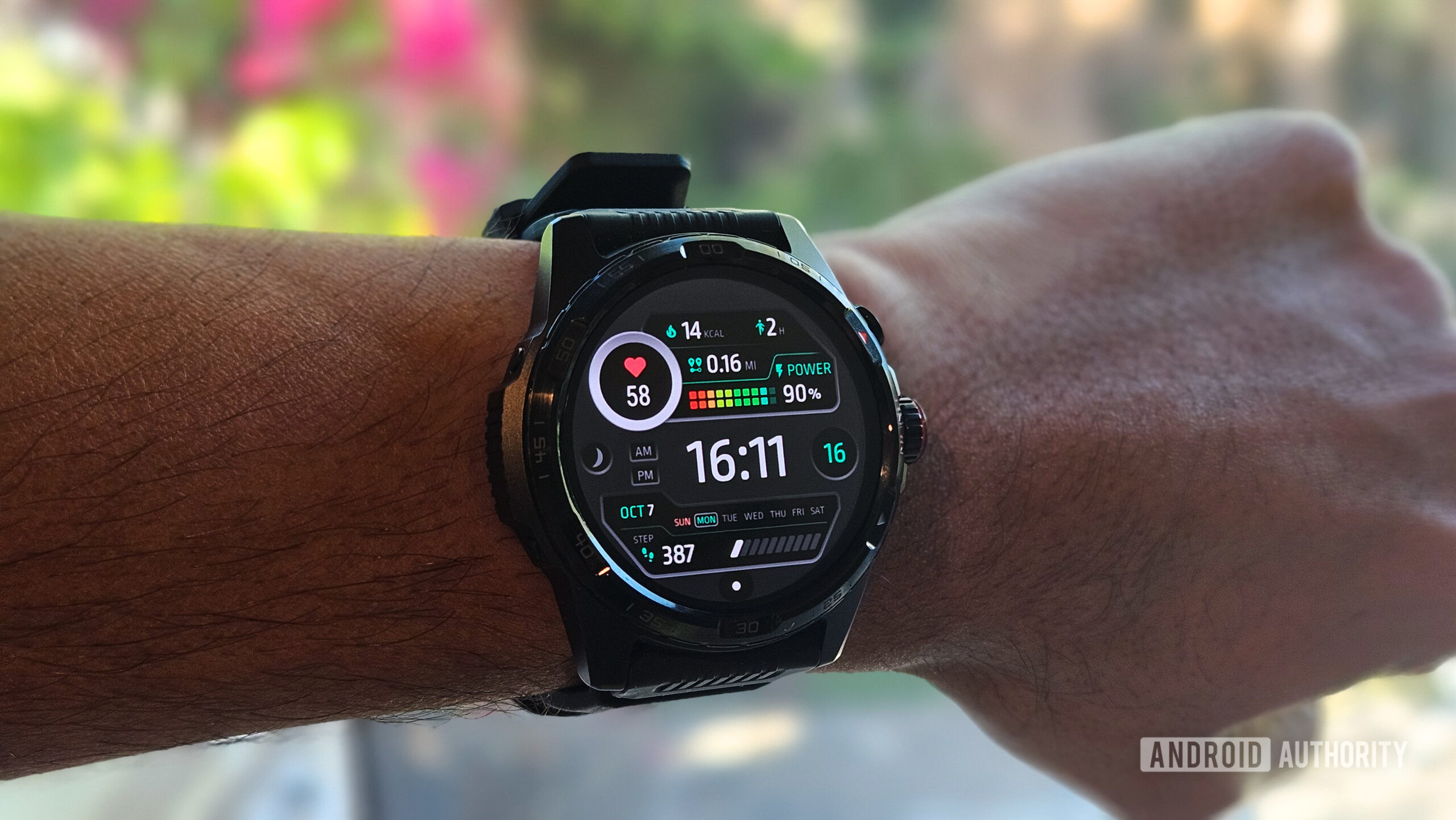The TicWatch Atlas nails the essentials with its sleek design, excellent battery life, and solid fitness tracking features. The dual-display is a clever touch, and performance is smooth throughout. The outdated software and lack of Google Assistant hold it back from being a perfect all-rounder, but for those who prioritize battery life and don’t mind missing a few cutting-edge features, it’s still a strong contender.
I’ve been testing out various smartwatches for over five years now, and my work has provided me the opportunity to try out a wide range of makes and models. In all that time, I’d never personally used a smartwatch that could give me a whole weekend’s worth of battery life, nor had I used a watch with two displays. That all changed with the TicWatch Atlas from Mobvoi, the brand’s ruggedized take on the Apple Watch Ultra and Samsung Galaxy Watch Ultra formula.
After spending two weeks with it, I have to say I genuinely enjoyed having it on my wrist. However, I’m still hesitant to recommend it as a top pick for most people due to a persistent issue we’ve seen with Mobvoi’s TicWatch line for a while now. If you’re considering the TicWatch Atlas, here’s what I think you need to know before buying one.
Comfortable, durable, and ready for anything

Rushil Agrawal /
One of the TicWatch Atlas’s defining features is its dual-screen design, which Mobvoi’s smartwatches are known for. That said, I didn’t even notice it until halfway through setting up the device. What immediately caught my attention was the premium look of the matte metallic back casing.
It’s crafted from sandblasted stainless steel, and the glossy bezel with orange accents gives it a sleek, high-end feel right out of the box. Right now, it’s only available in black, but Mobvoi plans to release a silver version down the line.
The raised bezel not only adds a classic aesthetic but also offers some protection for the sapphire crystal display. I haven’t had the chance to really put it through the rugged adventures that Mobvoi suggests this watch is built for, but I’m not particularly gentle with my wearables. The fact that the watch has managed to remain scratch-free during my testing is definitely a good sign.
Design-wise, the TicWatch Atlas feels like a solid pick for both formal and sporty occasions.
Thanks to the rotating crown, navigating the Atlas is a breeze. The watch’s vibration motor provides satisfying tactile feedback as you scroll, making interactions feel smooth and precise. A single press on the crown takes you to the app drawer, while a double press relaunches the last app you used. There’s also a second button on the top right that gives you quick access to recent apps and Google Wallet and also acts as a power button.
Rushil Agrawal /
At first glance, the fluoro rubber straps didn’t excite me — they looked a bit generic. But after wearing the Atlas for a while, I’ve come to appreciate their functionality. The ridged design with those large holes for the buckle does a fantastic job of keeping my wrist cool and sweat-free during workouts.
Compared to the sports band on my Galaxy Watch, which requires frequent adjustment during workouts, the Atlas strap felt much more breathable and secure. Plus, thanks to the quick-release mechanism, it’s easy to swap out the 24mm band with any third-party option.
Rushil Agrawal /
While the Atlas weighs a bit more than some other smartwatches, like the Pixel Watch 3 or Galaxy Watch 7, the 47 grams never felt cumbersome on my wrist. I wear a smartwatch to bed every night, so comfort is a big deal for me. Even with its 47mm case size, the TicWatch Atlas felt comfortable to wear 24/7. This is partly thanks to those airy straps, which, as I mentioned, kept my wrist surprisingly sweat-free even during California’s recent heatwave.
Mobvoi markets the TicWatch Atlas as an outdoor adventure watch, but it’s not quite as rugged as options like the Galaxy Watch Ultra, Apple Watch Ultra, or Garmin watches like the Fenix or Epix lines. It does have an IP68 and 5ATM water resistance rating, meaning it can handle dust and splashes with ease. I took it for a 30-minute swim in the pool, and it performed flawlessly. However, it lacks specific diving features, and those other adventure-focused watches often boast a 10ATM rating, allowing for use in deeper waters.
True to its name, the Atlas includes a compass and barometer, handy for those who enjoy exploring off the grid. But it doesn’t offer advanced features like offline navigation or TrackBack, which are found in the Galaxy Watch Ultra and Garmin watches. To be fair, though, these other models come with a much higher price tag, sometimes even more than double the Atlas’ $349 MSRP. Overall, the Atlas is still a solid choice for outdoors, just not the all-out adventure watch you’d want for a Man vs. Wild-level expedition.
What’s new on the TicWatch Atlas?
Compared to previous flagship Mobvoi smartwatches, such as the TicWatch Pro 5 Enduro, which launched earlier in 2024, the TicWatch Atlas introduces several noteworthy upgrades, including Heat Map Tracking, Fall Detection, and Enhanced TicMotion, which helps with auto-detecting workouts.
Thankfully, I didn’t get the opportunity to test the Fall Detection feature, but it’s a welcome addition for any smartwatch, especially one geared towards active users. The watch uses advanced sensors and AI to detect falls automatically and can trigger an SOS call with your location if needed. There’s also a manual SOS trigger, which is a great safety feature for outdoor enthusiasts.
The Heat Map Tracking feature is something that I haven’t seen on many mainstream smartwatches. It offers a personalized heat map that tracks your movements in various sports — perfect for analyzing your performance and seeing where you’ve been most active during a game. The feature is available for sports like American football, basketball, rugby, soccer, and a few others.
I didn’t have the chance to test it fully in a competitive match. However, I did turn on the soccer mode and walked around my backyard. From the heat map above, it seems like the GPS locked onto my position accurately enough for me to feel confident that it would work well in a real game.
You can also share the heat map to your socials or download it using one of the in-built templates. It’s a cool feature, but probably not something most people will use every day unless you’re heavily into sports tracking.
Combining nostalgia and innovation
Rushil Agrawal /
Now, let’s dive into what sets the TicWatch Atlas apart. The TicWatch Atlas features a standard 1.43-inch OLED screen with a 466 x 466 resolution, but it also has an “ultra-low-power” LCD panel. This secondary screen brought back memories of monochrome digital watches I wore as a kid. But nostalgia isn’t the only reason I appreciated its existence here.
For one, I noticed that in bright outdoor sunlight, the low-power display is actually easier to read than the OLED. The low-power screen is simply dark text on a plain background, which holds up better in direct sunlight compared to the OLED, where a dark watch face might make visibility more of a challenge.
The LCD has a customizable backlight in 18 different colors, and you can use the rotating crown to toggle through heart rate, calories burned, SpO2 readings, and even the compass, all without waking up the main display. I even set up the watch to only light up the low-power screen for the Tilt-to-wake functionality, which does everything you need it to — without draining your battery.
The real beauty of the TicWatch Atlas’ dual display is that it delivers Always-On Display (AOD) functionality without hammering the battery.
I’ve always avoided using AOD on smartwatches simply because I hate how quickly it drains the battery. But the TicWatch Atlas solves that issue for me. If you prefer, you can use the OLED for AOD too — but, as expected, that’ll hit your battery harder.
One minor drawback of the dual-display design is that the OLED seems a tad less bright than it could be, almost like it’s covered with a faint 10% transparency filter. But honestly, it’s a small trade-off for the benefits you get in return.
Powering through your day(s)
Rushil Agrawal /
And what are these benefits, you ask? The biggest one is extended battery life, which is a major selling point for the TicWatch Atlas. This watch packs a massive 625mAh battery, which dwarfs the batteries found in most other smartwatches, including the larger variants of the Galaxy Watch 7, the Pixel Watch 3, and even the Galaxy Watch Ultra.
As I expected, the Atlas lasts significantly longer than my Galaxy Watch 7. I’ve consistently been getting more than three full days of use, including sleep tracking and regular activity monitoring — something I’ve never experienced with any other smartwatch.
On days when I wasn’t logging any workouts, the battery dropped only by about 15-20% in 24 hours, which is impressive. On days when I did track workouts, the battery drained a bit faster, but the Atlas still had about 50% left after 24 hours, whereas the Galaxy Watch 7 dropped to about 30% during that time.
While I’m head over heels for the battery life, I’m not a fan of the Pogo pin charger. Wireless charging would have been nice to have. However, it’s a compromise I’m willing to make for this level of endurance. My only other complaint is that the charger uses a USB-A cable. Most of my devices are USB-C now, so having to dig up an old adapter was a slight inconvenience.
Gets the tracking basics right
Rushil Agrawal /
The TicWatch Atlas has dedicated fitness tracking modes for about 100 different activities. I put it to the test with outdoor walks, pool swims, and general daily activity monitoring. The built-in GPS accurately mapped my routes, and the heart rate monitoring seemed to be on par with my Galaxy Watch 7 (though I don’t have any medical-grade equipment to confirm absolute accuracy).
Remember that handy secondary display? You can use it during workouts to monitor your vitals at a glance, and it pulls off a neat trick — its backlight changes color based on your heart rate zone. It’s a simple yet effective way to help you pace your workouts without needing to swipe or tap the main screen.
One area where the TicWatch Atlas stumbles is sleep tracking.
The watch does a decent job of identifying sleep cycles, from deep sleep to REM, but for sleep tracking in general, it struggles to differentiate between lying awake in bed and actually dozing. I often spend about 20 minutes each morning reviewing my to-do list while still in bed, and the Atlas consistently counted this time as sleep. To be fair, many fitness wearables have this issue, but my Galaxy Watch seems to be a bit more accurate in this regard.
To track your data and tinker with the watch, you’ll use the Mobvoi Health app (available only on Android — the TicWatch Atlas isn’t compatible with iOS). While the app is visually appealing and packed with detailed graphs and charts, I found the performance to be a bit sluggish. There’s a noticeable choppiness when switching between pages, almost as if it’s loading web pages within the app. It’s not a deal-breaker, but it does detract from the overall experience.
On the plus side, the app is quite functional, which hasn’t always been the case with Mobvoi’s apps. It syncs your health data with Google Fit, allows you to tweak watch settings, and offers a decent selection of watch faces. I also liked the ability to customize watch face complications to display the information I find most useful. For a wider variety of watch faces, you need to install a separate Timeshow app.
As for the software, the TicWatch Atlas runs on Google’s Wear OS, and Mobvoi doesn’t mess with the experience too much. There are a few Tic-branded apps for workouts, stats, and other essential functions, but overall, it stays close to the stock Wear OS feel. Thanks to the Snapdragon W5 Plus chipset — same as the one in the Pixel Watch 3 — the watch is pretty snappy. In fact, it often felt more responsive than my Galaxy Watch 7.
It wouldn’t surprise me if the Atlas doesn’t see Wear OS 5 until Wear OS 6 is already on the horizon.
That said, the software has one downside: the Atlas comes running on Wear OS 4, which is more than a year old at this point. Wear OS 5 brings some solid improvements like better battery efficiency and faster app loading times, not to mention new running metrics and watch face enhancements.
While Mobvoi will likely update the TicWatch Atlas to Wear OS 5 eventually, the company hasn’t committed to a timeline. Given that it took the TicWatch Pro 5 series a while to get Wear OS 4, it wouldn’t surprise me if the Atlas doesn’t see Wear OS 5 until Wear OS 6 is already on the horizon.
TicWatch Atlas review verdict: A compelling choice with a few caveats
Rushil Agrawal /
The TicWatch Atlas next to a Galaxy Watch 6 Classic
The TicWatch Atlas looks sleek (for a rugged watch, anyway), feels great for all-day wear, and boasts an exceptional battery life that outshines much of the competition. The dual-display design is more than a gimmick — it’s genuinely useful, and the watch’s overall performance is snappy. It has all the essential fitness and health-tracking features you’d expect, along with a few cool extras like heat map tracking.
As someone who depends on a smartwatch daily but had never tried a Mobvoi watch before, I’ve come away really impressed.
The only major drawback here is the software support. While a Wear OS 5 update is likely, Mobvoi hasn’t provided a clear timeline, and the lack of Google Assistant support further limits its smart capabilities. If keeping your devices up-to-date with the latest software is a dealbreaker, this might give you pause, especially since Wear OS is still evolving, and each update brings meaningful improvements.
There are a few other minor hiccups, like the Mobvoi app feeling a little unrefined at times and the sleep tracking needing some fine-tuning. Additionally, if you’re already locked into Samsung or Google’s ecosystems, you’ll miss the tight integration between your phone and watch. For instance, with my Galaxy Watch, enabling sleep mode on either my Samsung phone or watch syncs it across both devices, whereas with the TicWatch, I had to do it manually on both.
Rushil Agrawal /
The TicWatch Atlas is priced at $349.99, available through Mobvoi and third-party retailers like Amazon. That puts it just above the Galaxy Watch 7 ($299.99 at Amazon) and on par with the smaller Pixel Watch 3 ($349.99 at Amazon).
If you prioritize exceptional battery life and appreciate unique features like heat map tracking, the Atlas is a compelling choice. But, for those who heavily rely on their smartwatch as an extension of their smartphone and value the latest software features and ecosystem benefits, options from Samsung or Google might be a better fit.
If your top priority is unparalleled battery life, or if you’re primarily interested in activity tracking during your outdoor adventures, the Garmin Fenix series is worth considering. However, be prepared for a significantly higher price tag. Another excellent option for outdoor enthusiasts is the Galaxy Watch Ultra ($499.99 at Amazon). It offers a broader range of adventure-focused features, multi-day battery life, and special perks for Samsung users, but it also comes at a premium cost compared to the TicWatch Atlas.
The TicWatch Atlas is an Apple Watch Ultra and Galaxy Watch Ultra alternative at almost half the price.
If you’re not as concerned with outdoor features but still crave extended battery life, the OnePlus Watch 2 ($299.99 at OnePlus), with its unique dual-chip architecture, delivers impressive endurance at a slightly lower price point.
Alternatively, if you can live without heat map tracking and the emergency SOS feature, consider the TicWatch Pro 5 Enduro ($349.99 at Amazon). It offers a similar feature set and impressive battery life and is often selling for a discount now, but keep in mind that it might lag even further behind in terms of software updates.
Ultimately, the decision comes down to your priorities. As our wearables expert, Kaitlyn aptly summed up in her review of a previous TicWatch model, “The real question is whether your priority is to access the best software available or tap into the best battery life. For Mobvoi’s sake, I hope shoppers don’t always have to choose.” Unfortunately, that’s still the case with the TicWatch Atlas, but I still have to commend Mobvoi for making a compelling Apple Watch Ultra and Galaxy Watch Ultra alternative at almost half the price.
Mobvoi TicWatch Atlas
Stylish, ruggedized design • Class-leading battery life • Heat map tracking
Ruggedized Wear OS watch.
The TicWatch Atlas takes on the Samsung Galaxy Watch with a ruggedized design for adventurers, Mobvoi’s signature dual-display, and amazing battery life.





